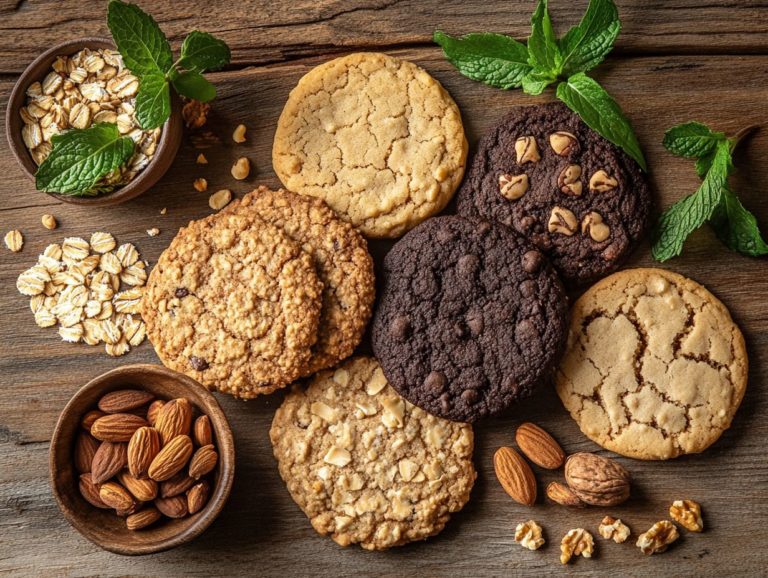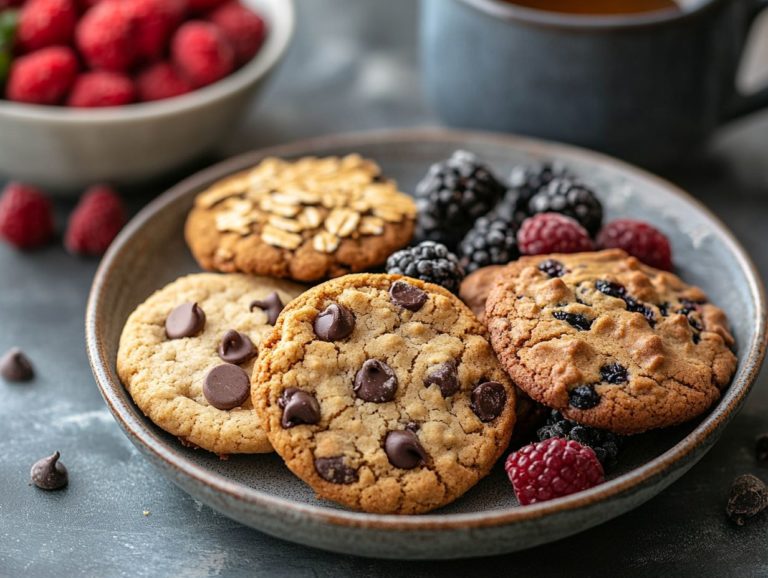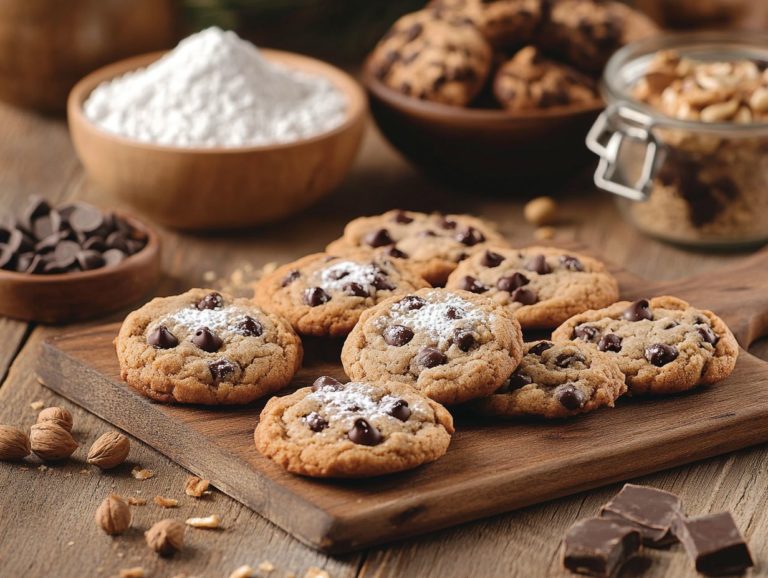How to Store Plant-Based Cookies for Freshness
Storing plant-based cookies and dough correctly isn’t just important; it’s essential for enjoying every bite of your delicious creations! Keeping them tasty and fresh is crucial, whether you’ve just whipped up a fresh batch or picked up some store-bought treats. Understanding the best techniques can truly elevate your cookie experience.
Choosing the right containers think airtight options or elegant glass jars plays a significant role in maintaining freshness. This guide will equip you with everything you need to know about storing your cookies in the fridge or freezer to keep them tasting sublime for as long as possible.
Moreover, you’ll uncover tips on how to identify stale cookies and rejuvenate them, bringing back that irresistible just-baked goodness!
Contents
- Key Takeaways:
- Why Store Plant-Based Cookies?
- Best Containers for Storing Plant-Based Cookies
- Storing Plant-Based Cookies in the Freezer
- Thawing and Reheating Instructions
- How Long Can You Store Plant-Based Cookies?
- How to Tell if Plant-Based Cookies Have Gone Bad?
- How to Refresh Stale Plant-Based Cookies?
- Frequently Asked Questions
- What is the best way to store plant-based cookies for freshness?
- How long can I store plant-based cookies for freshness?
- Can I freeze plant-based cookies for freshness?
- Should I store different types of plant-based cookies separately for freshness?
- Can I use the same storage method for all plant-based cookies?
- How do I know if my plant-based cookies have gone bad?
Key Takeaways:

- Proper storage is essential for maintaining freshness and flavor of plant-based cookies.
- Airtight containers, glass jars, and plastic bags are suitable options for storing plant-based cookies.
- Labeling and dating containers, wrapping cookies properly, and following thawing, freezing, and reheating instructions can prolong the storage life of plant-based cookies.
Follow these tips and never settle for stale cookies again!
Why Store Plant-Based Cookies?
Proper storage is crucial for enjoying the taste and texture of plant-based cookies. These cookies, like rich chocolate chip and creamy peanut butter varieties, require specific methods to maintain freshness and prevent them from going stale. Bakers like Chris Malloy, Jessica Levinson, and Isaac Winter recommend effective techniques to keep your leftover cookies soft and delicious for as long as possible. By mastering the art of proper cookie storage, you not only enhance your overall cookie experience but also minimize food waste.
With the right approach, you can significantly extend the lifespan of your treats, ensuring that your favorite cookie recipes are ready to satisfy your cravings whenever they arise.
Best Containers for Storing Plant-Based Cookies
Selecting the ideal containers for storing your plant-based cookies is essential for preserving their freshness and texture over time. Opt for airtight containers, glass jars, or plastic bags each of these options helps establish a controlled environment that effectively slows the onset of staleness.
When choosing a container, take into account the type of cookies you re storing, whether they re soft or dry, and how long you plan to keep them. This way, you can ensure that your delectable treats remain just as delightful as the day they were baked, whether they are chocolate chip cookies, peanut butter cookies, or even delicate ricotta cookies.
1. Airtight Containers
Airtight containers are your best bet for storing cookies, as they efficiently seal out air and moisture two enemies that can turn your delightful treats into stale disappointments. By opting for an airtight container, you create the perfect environment for both soft and dry cookies, preserving their unique textures and flavors. These containers come in a variety of sizes and materials, offering versatility for any kitchen and ensuring your cookie creations remain as fresh as possible.
Selecting the right size is essential; for example, a smaller container is ideal for softer cookies, preventing them from becoming overly compact. On the other hand, larger options are perfect for crispy varieties, allowing them to breathe without the risk of breakage.
Material matters, too glass containers often provide better insulation, while plastic ones are lighter and more portable. To maximize freshness, consider lining the container with parchment paper to absorb any excess moisture, creating a cushioned layer for your delicate cookies.
This level of care not only extends the shelf life of your freshly baked treats but also elevates the pleasure of every single bite.
2. Glass Jars
Glass jars are not just a feast for the eyes; they also serve as an impeccable solution for cookie storage. They shield your delectable treats from moisture and pests while elegantly displaying the cookies’ charm.
Choosing a glass cookie jar adds a touch of sophistication to your kitchen. It fulfills the essential task of preserving freshness.
Sealing the lid tightly is essential to keep your cookies flavorful. This is crucial for maintaining the rich flavors of your favorite cookies.
Beyond their visual allure, glass jars create an airtight environment that significantly reduces the chance of your cookies becoming stale. The transparency of the glass offers an enticing glimpse of the cookies within, making them irresistibly tempting to guests who happen to drop by.
Whether you’re storing batch after batch from your favorite cookie recipe, such as meringue cookies or biscotti, glass jars keep them fresh.
To ensure your cookies enjoy a long and flavorful life, take the time to clean the glass jars thoroughly before using them. This ensures they are devoid of any residues from previous contents. A simple wash with warm, soapy water followed by complete air drying will do the trick.
Once you ve filled the jars, pressing the lids down firmly will create a secure seal that keeps unwanted air out, promoting optimal freshness for your delightful cookies.
3. Plastic Bags
Plastic bags present a convenient and space-efficient solution for storing your cookies, particularly when freezing them for extended periods. When sealed properly, these bags work wonders in preventing air exposure and moisture two main culprits that compromise the freshness of your leftover cookies.
This method effectively preserves the delightful flavors and textures of various cookie types. It also makes it a breeze to portion out snacks for future indulgence.
Using plastic bags streamlines your storage process. It allows you to stack cookies neatly in the freezer without consuming much space. To achieve optimal freshness, aim to remove as much air as possible before sealing the bags.
A vacuum sealer can be a game-changer, but simply pressing out the excess air with your fingers works just fine too.
Don t forget to label the bags with the cookie type and the date of storage. This little touch creates an organized system that makes it easy to identify your treats later.
By employing these techniques, you can relish in the joy of homemade cookies at their best, even weeks after they were baked. Whether freezing cookies or enjoying fresh cookies, plastic bags offer an excellent storage solution.
How to Store Plant-Based Cookies in the Fridge?
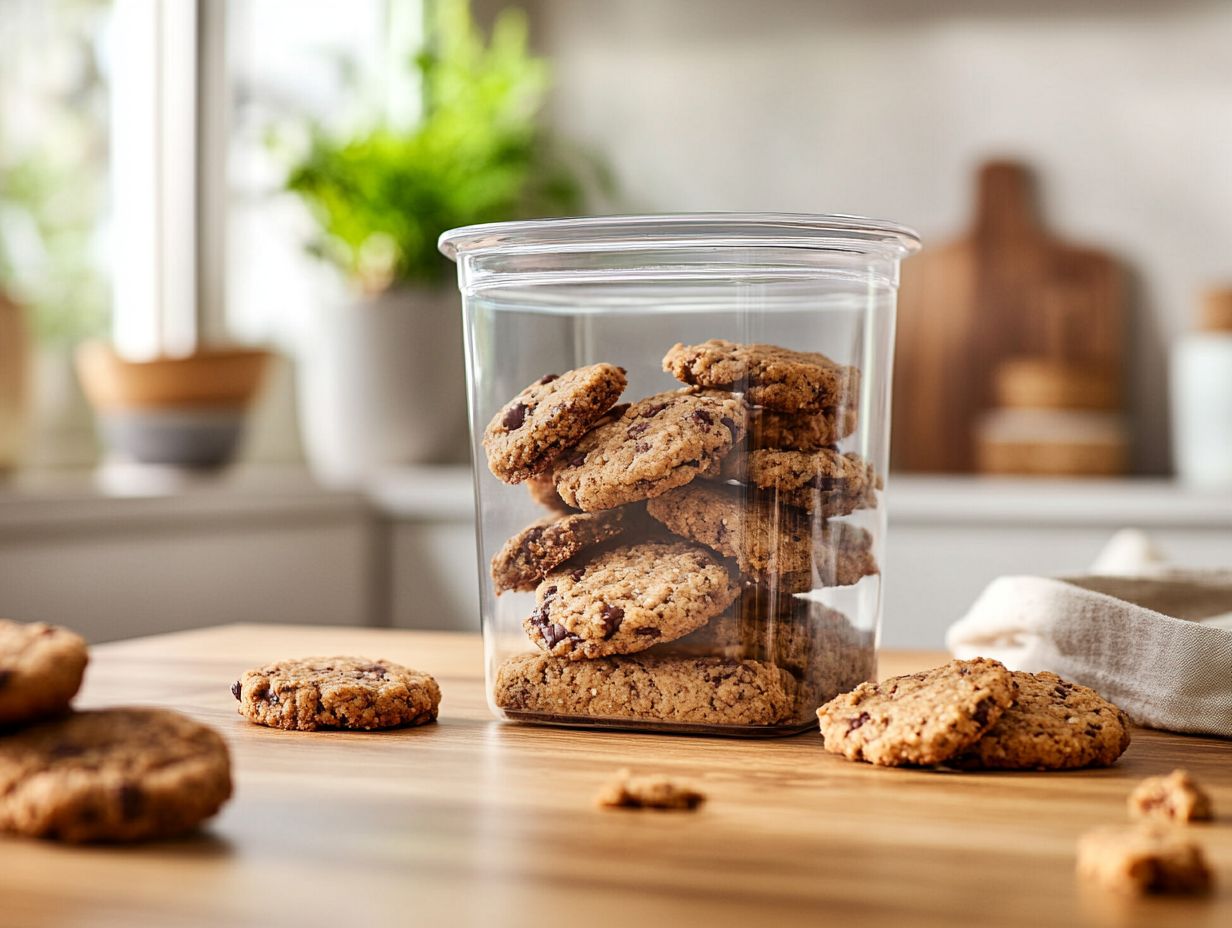
Storing your plant-based cookies in the fridge is a smart move to extend their freshness, especially for recipes featuring moist or perishable ingredients.
To achieve optimal results, start by wrapping the cookies carefully to shield them from any unwanted odors or moisture. Next, transfer them into an airtight container. Don t forget to label and date it. This way, you can effortlessly track their freshness and savor your delightful treats at their peak. These baking tips ensure that your food pantry remains organized and your cookies stay fresh.
1. Wrap the Cookies Properly
Wrapping cookies properly is your first crucial step to maintaining their freshness while they re chilling in the fridge. Use plastic wrap or aluminum foil to tightly encase each cookie, making sure they re completely covered and shielded from moisture and any lingering odors that could compromise their quality.
This technique is especially vital for soft cookies, as it helps preserve that delightful chewy texture for an extended period. If your cookies sport delicate toppings or icing, consider laying down a sheet of wax paper before the final wrap for an extra layer of protection.
When sealing the cookies, be attentive to pressing out any excess air trapped inside; this simple step can prevent freezer burn and keep your cookies from going stale over time.
For firmer cookies, opt for an airtight container with parchment paper between the layers. This approach helps maintain their crispness without sacrificing flavor. By properly wrapping different types of cookies, you significantly extend their shelf life, ensuring that your chocolate chip and oatmeal raisin cookies remain just as delightful even after days in storage.
Following these reheating cookies tips ensures they taste freshly baked.
2. Place in an Airtight Container
Placing your wrapped cookies in an airtight container is essential for preserving their freshness while stored in the fridge. Airtight containers help keep moisture away and prevent unwanted odors from other foods from seeping in. This ensures that your cookies taste just as delightful as when they came out of the oven. This storage method is particularly beneficial for cookies that have a higher moisture content, such as those made with nut butter or chocolate.
Choosing the right type and size of container for different cookie varieties can significantly extend their lifespan. For instance, softer cookies should be kept in a moderately-sized, airtight container to maintain that perfect chewy texture. In contrast, firmer cookies can thrive in larger containers without losing their crispiness.
Consider opting for containers made of glass or safe plastic, as these materials are not only durable but also offer excellent sealing properties. If you’re dealing with delicate cookies, containers with dividers can be a game-changer. They prevent breakage during storage and allow you to keep various flavors and textures intact. These kitchen materials will help preserve freshness effectively.
3. Label and Date the Container
Labeling and dating your containers not only helps you track the storage duration but also ensures you use the older batches first, avoiding any food waste. This is especially useful when you have a variety of cookie types in your pantry.
An organized kitchen with properly labeled containers can make a significant difference in preserving the freshness of your baked goods. By marking each container with the storage date and the type of cookies inside, you can effortlessly monitor their freshness and ensure that you enjoy your leftovers at their prime. This approach is beneficial for those who love to bake a variety of cookies or prepare cookie dough in advance, helping you indulge without the guilt of waste.
This method simplifies identifying the delicious treats you have on hand and aids in managing your baking routine with finesse. To implement this technique effectively, consider using stickers or a permanent marker to clearly indicate what type of cookies are stored in each container. This is particularly useful for distinguishing between soft cookies, dry cookies, and different cookie types.
Also, employing a tiered system in your fridge can streamline access, allowing you to quickly grab your favorite cookies without having to rummage through a chaotic array of containers. This organization method is especially beneficial for managing cookies with different shelf lives. By embracing this straightforward strategy, you can relish your baked goods at their peak freshness, reducing waste and amplifying your overall enjoyment.
Storing Plant-Based Cookies in the Freezer
Freezing cookies offers a superb method to extend their shelf life, allowing you to savor your favorite treats long after baking day has passed.
To effectively store plant-based cookies in the freezer, start by wrapping them carefully to prevent freezer burn and keep their delightful texture intact. This is especially true when freezing cookies that are more delicate, like ricotta cookies or meringue cookies. Once you’ve wrapped them, place the cookies in a freezer-safe container that s airtight to maintain their freshness.
And remember, it s wise to label and date the container for easy identification when the moment strikes for a sweet indulgence. This simple step is key to properly storing cookies and ensures you enjoy them at their best. Don’t wait too long to enjoy your frozen treats!
1. Wrap the Cookies Properly
Wrapping cookies properly before freezing is essential for preserving their quality during extended storage. Use plastic wrap or freezer bags to tightly enclose each cookie, ensuring they are shielded from air exposure. This step is crucial for all cookies. Soft cookies are especially prone to drying out in the freezer.
Plus, using good wrapping materials, consider separating cookies with layers of parchment paper to further protect delicate varieties from sticking together.
For sturdier cookies, while they may handle a little less meticulous storage, taking the time to wrap them securely will still enhance their taste and texture.
Improperly wrapped cookies can suffer from freezer burn, resulting in an undesirable icy coating that greatly diminishes their flavor profile.
So, whether you re dealing with a chewy chocolate chip, a crunchy biscotti, or even peanut butter cookies, investing effort in proper wrapping techniques will ensure they remain delightful for your future enjoyment.
2. Place in a Freezer-Safe Container
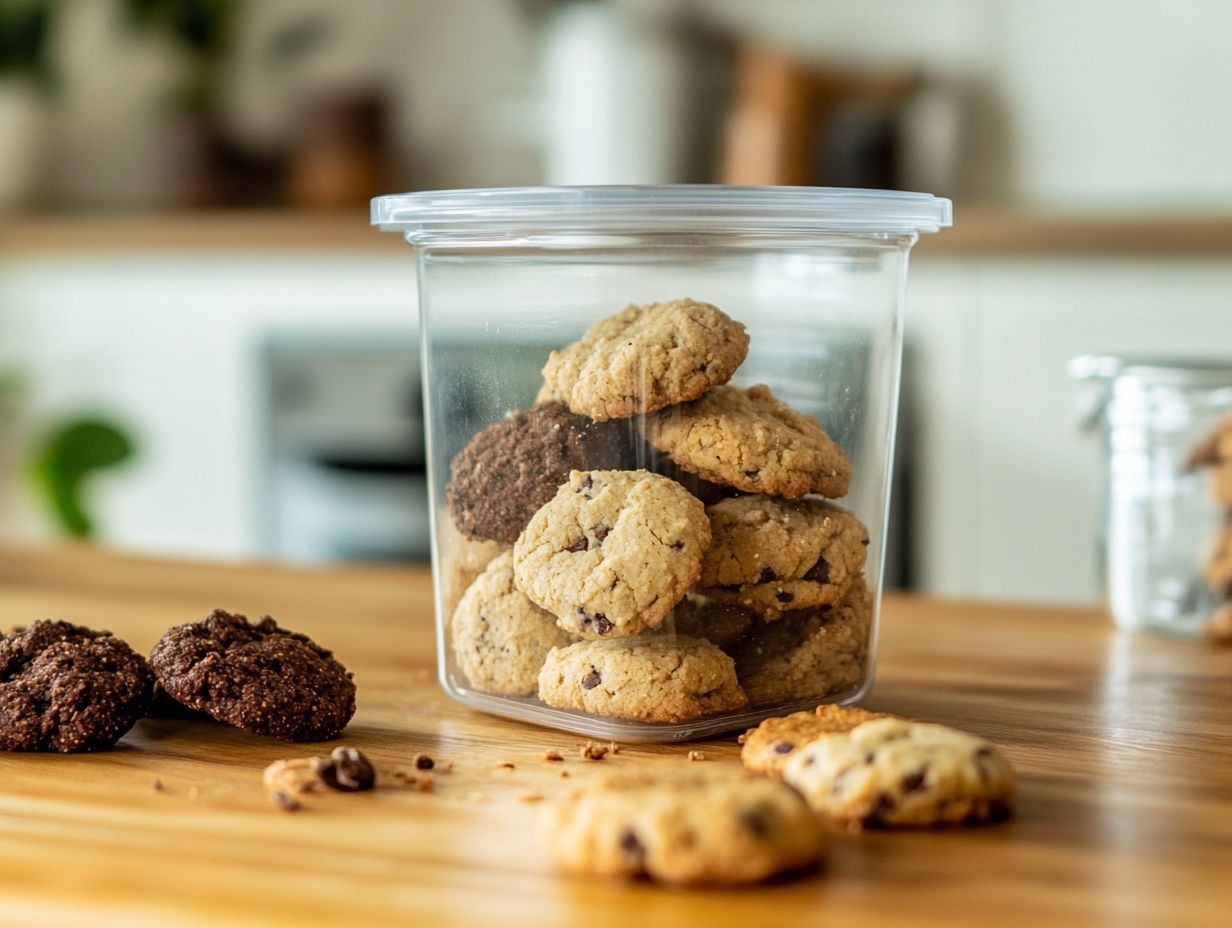
Using a freezer-safe container is crucial for optimal cookie storage in the freezer, adding extra protection from air and moisture. Once you’ve wrapped your cookies, simply transfer them to a container specifically designed for freezer use, ensuring it s airtight to prevent any unwanted exposure to the elements. This step is key to maintaining the texture and flavor of your cookies, allowing you to savor them just as if they were freshly baked.
Quality freezer-safe containers are typically crafted from durable materials like glass, plastic, or silicone, designed to endure low temperatures without cracking or warping.
Consider the size of your container. It should be roomy enough to hold your cookies without overcrowding, yet not so large that it leaves excess air inside, which can lead to freezer burn. For delicate cookies, choose a smaller, snug container, while sturdier varieties like biscotti can comfortably reside in larger ones.
By selecting the right materials and sizes for different cookie types, you ensure lasting freshness and a delightful treat whenever the craving strikes.
3. Label and Date the Container
Labeling and dating your freezer-safe container is a smart and efficient strategy for managing your cookie storage, ensuring you savor them at their peak freshness. By marking the date of freezing and specifying the type of cookies, you can effortlessly track how long they’ve been tucked away and determine when they should be enjoyed for the best flavor. This simple habit ensures no delicious treats get lost in your freezer!
Freshness is essential for preserving the quality of your cookies because even frozen delights can lose their original taste and crispness over time. Enjoy your homemade frozen cookies within three months for the best taste! Anything beyond that may lead to a dull flavor and a texture that s far from appealing.
To maintain optimal freshness, consider using a permanent marker for labeling or even color-coded stickers to make identification quick and effortless. By adopting these best practices, you can truly relish the delightful qualities of your cookies, enhancing every bite with rich flavors and satisfying textures.
Thawing and Reheating Instructions
Thawing and reheating your frozen cookies correctly is essential for bringing back their original texture and flavor. This will allow them to taste as if they were just pulled from the oven!
To thaw your cookies, simply take them out of the freezer and place them in the refrigerator for several hours or overnight. If you’re short on time, leave them at room temperature for about 30 minutes. This works wonders too!
If you crave warm cookies, pop them in the oven at a low temperature for a few minutes until they re warm and inviting.
Keep in mind that each cookie type has its own special qualities! Different varieties have distinct moisture levels and baking traits. For chewy delights like chocolate chip or oatmeal cookies, reheating them for just 5-7 minutes helps restore their soft and tender qualities. On the other hand, crisp cookies, such as biscotti, might only need a quick warm-up of 3-5 minutes to maintain their satisfying crunch.
Always store your cookies in airtight containers to lock in moisture during the thawing process. By following these best practices, you’ll not only preserve the deliciousness of your cookies but also elevate your enjoyment as if they were freshly made!
How Long Can You Store Plant-Based Cookies?
The storage duration for plant-based cookies can vary considerably, influenced by factors such as the ingredients you choose and the storage methods you implement. Understanding baking tips will enhance your ability to maintain their quality.
Typically, when you stash fresh cookies in the fridge, they can remain delightful for about 5 to 7 days. On the other hand, if you opt to freeze them, their quality can be preserved for several months.
Knowing how long you can keep your cookies in the fridge or freezer is crucial for savoring your favorite treats at their peak freshness. This allows you to fully enjoy the rich flavor and texture that your baking deserves!
1. In the Fridge
When you store plant-based cookies in the fridge, you can generally expect their freshness to last about 5 to 7 days. However, this also depends on the specific ingredients in your recipe.
Cookies featuring wet ingredients, like fruits or nut butters, might not last as long, while drier varieties can hold up a bit better.
To keep your cookies as delicious as the day you baked them, always opt for an airtight container and consider labeling it with the date you stored them.
Reviewing the ingredient list is crucial! For example, cookies loaded with high-fat ingredients like oils or coconut can enhance texture and prolong freshness, but they might also need closer attention for any signs of spoilage.
Keep an eye out for visual cues notice any changes in color or texture. Don t hesitate to conduct a sniff test to detect any off odors.
Consistent refrigeration is your ally in slowing down the growth of mold and bacteria, especially for baked goods that contain perishable elements like chocolate chips or dairy alternatives. Proper cookie storage ensures longevity and quality!
By following these simple guidelines, you can savor your delightful treats for days to come. Keeping a cookie jar in your food pantry can also help maintain their freshness!
2. In the Freezer
When you store plant-based cookies correctly in the freezer, you grant them a much longer lifespan typically lasting anywhere from 2 to 3 months without sacrificing quality. This extended storage time allows you to bake in bulk and indulge in your favorite treats whenever the craving strikes!
To prevent freezer burn, which can compromise both texture and taste, it’s crucial to wrap and store them properly.
To maximize freshness, consider using airtight containers or durable freezer bags, ensuring that you remove as much air as possible. Labeling the containers with dates will help you keep track of how long they ve been stored. Over time, even well-stored cookies may start to lose some of their delightful crunch or flavor, especially if they mingle with odors from other foods in the freezer.
While the initial freezing process is undoubtedly beneficial, adhering to best storage practices is essential for maintaining the highest quality throughout their shelf life!
How to Tell if Plant-Based Cookies Have Gone Bad?
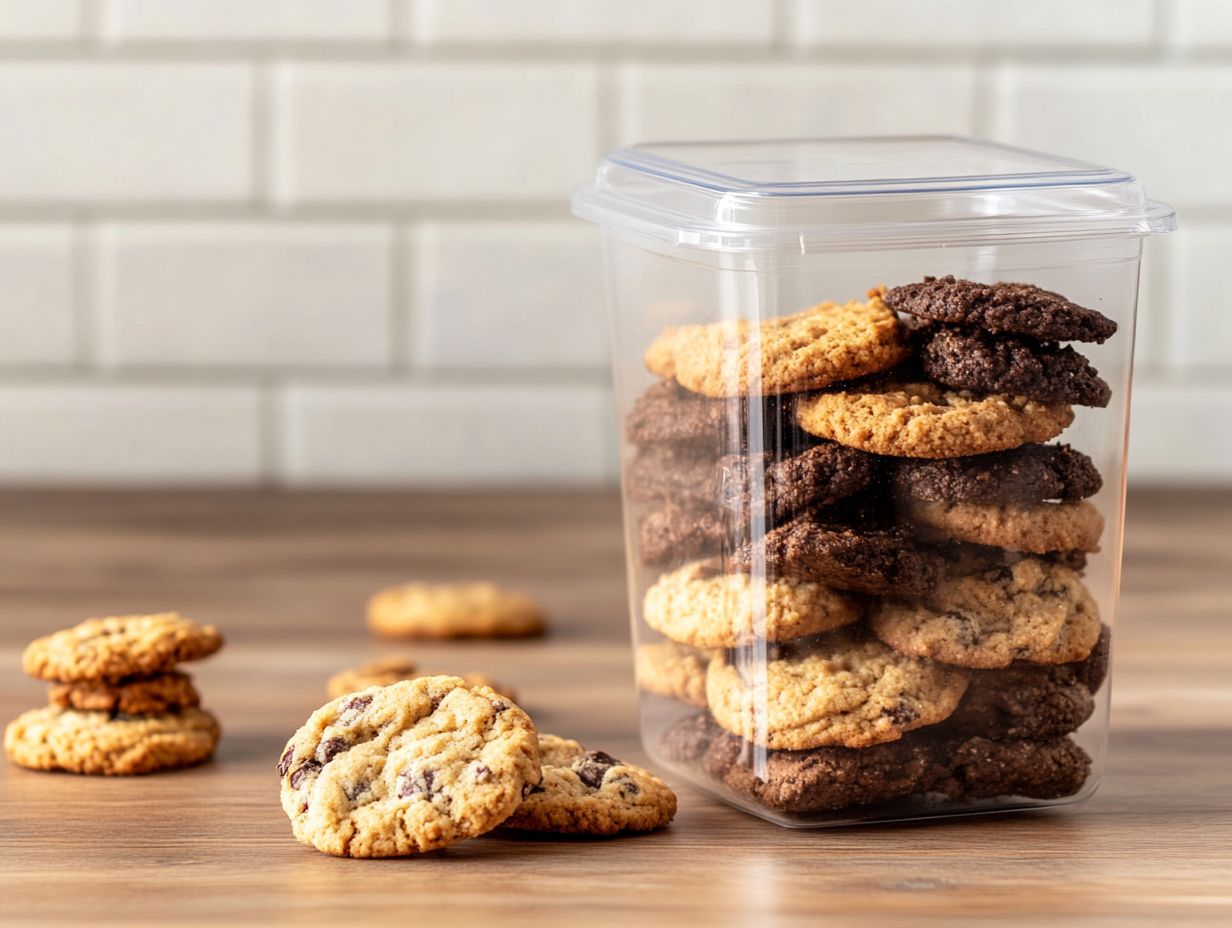
Identifying whether your plant-based cookies have gone bad can be quite straightforward if you know what to look for. Common signs of stale cookies include changes in texture, such as becoming overly hard or dry.
Additionally, be aware of any off-putting odors that might arise from the ingredients breaking down. If you spot any discoloration or visible mold, it s wise to err on the side of caution and discard the cookies to prioritize your health and safety. Consulting experts like Chris Malloy or Jessica Levinson can provide further insights on identifying spoiled cookies.
It s crucial to consider the specific type of plant-based cookies in question, as different recipes can exhibit varied signs of spoilage. For example, cookies made with nut butters might develop an oily sheen or a rancid smell, while those containing fruit could attract mold or become excessively soggy. Think about how long you ve stored them; cookies kept in a humid environment may spoil faster. Cookie types like peanut butter cookies and chocolate chip cookies often have specific storage needs to prevent spoilage.
When in doubt, trust your senses smell, touch, and visual inspection can serve as your best allies in assessing the freshness of these delightful treats. Always refer to your cookie recipe for specific storage instructions and tips.
How to Refresh Stale Plant-Based Cookies?
Reviving stale cookies from renowned brands such as Whisked! and Tusitala can be a fun and delicious adventure!
Refreshing stale plant-based cookies is a simple yet rewarding process that can bring them back to life, allowing you to relish the original flavors and textures you once adored. This is one of the most important baking tips you can use to ensure your stale cookies become fresh cookies again.
One effective method is to reheat the cookies in the oven at a low temperature for a few minutes. This will restore their softness and warmth, making them irresistible once more. This method is particularly effective for cookie dough that has been refrigerated.
Place the stale cookies in an airtight container with a slice of bread. This little trick helps reintroduce moisture, reviving their freshness and making them enjoyable again. This method works well for leftover cookies.
If you prefer chewy cookies, consider adding a damp paper towel to the container to enhance moisture levels, resulting in a soft, pillowy texture. For more delicate cookies, like those studded with nuts or chocolate chips, a gentle reheating in the microwave with short intervals can work wonders, ensuring they don t become overcooked. For peanut butter and ricotta cookies, reheating can be especially tricky, so monitor them closely.
You might also want to experiment with steam methods, such as briefly placing the cookies in a steamer, which cooks food with steam and can revive stale cookies. This technique can yield delightful results and mimic that freshly baked sensation. Experts like Isaac Winter from Southern Living often recommend this method.
By utilizing these various techniques, you can savor your favorite cookie varieties just as you intended, brimming with flavor and achieving that ideal consistency. Don t hesitate to store your cookies in a cookie jar to maintain their freshness.
Watch this video for more tips on cookie storage!
For more baking tips and expert advice, follow renowned bakers and organizations like Southern Living and Heartland Alliance.
Frequently Asked Questions
Here are some FAQs related to cookie storage and preserving freshness for your delicious plant-based cookies, featuring advice from experts at Washington Post and NPR.
According to experts from Heartland Alliance, the best storage method is key to maintaining cookie freshness. The best way to store plant-based cookies for freshness is to keep them in an airtight container or resealable bag. This will prevent air and moisture from getting in and causing them to become stale. Using proper kitchen materials can also help in preserving freshness.
According to Lake Forest College, cookies have best storage times. Plant-based cookies can be stored for about 1-2 weeks.
The exact time may depend on the ingredients and conditions. Freezing cookies extends their shelf life significantly.
Freezing cookies is a great way to extend their shelf life. Wrap them tightly in plastic wrap or place them in an airtight container before freezing.
They can be enjoyed for up to 3 months in the freezer! This method works well for many types of cookies, including meringue cookies (light, airy cookies made from whipped egg whites) and shortbread cookies.
Experts from Above and Beyond Family Recovery Center recommend storing different types separately. This practice helps maintain freshness and prevents flavors from mixing.
For example, keep gingersnaps separate from biscotti to preserve their unique flavors.
Most cookies can be stored similarly. However, check specific storage instructions for each recipe.
Some specialty cookies may need a different method for maximum freshness, especially those from a food pantry.
Experts like those from the Washington Post can help you identify spoilage signs. If your cookies appear stale, dry, or moldy, it s best to trust your senses.
Discard any cookies that don t look or smell fresh. Remember, if they smell off or look stale, it s time to toss them!



